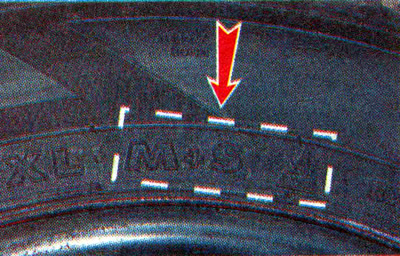Check the operation of the air conditioner heater. In order not to suddenly find yourself in an unheated car interior during the first frosts, before the onset of cold weather, turn on the air conditioning system in the heating mode and make sure that the heater is working.
Then, in case of a malfunction, it will be possible to repair the air conditioner before the first frost.
Check heated rear window. If during the season you did not have to turn on the heating to prevent fogging of the rear window, then this operation must be performed.
A slight damage to the thread of the heating element can be repaired with a special repair compound.
Check coolant density or replace coolant according to maintenance plan (see «Maintenance plan»).
By density, you can determine the state of the coolant and its compliance with climatic conditions (see «Checking the technical condition of the cooling system»). If the density is found to be low, the coolant must be replaced (see «Coolant - replacement»). A decrease in density is possible if water was added to the cooling system, due to which the concentration of ethylene glycol became lower. In summer it is not as significant as in winter. In cold weather, at a low concentration of ethylene glycol, the coolant can turn into a mushy mixture or even freeze if a large amount of water is added to the cooling system.
Check battery condition. As long as the temperature is positive outside, the battery, even if it is discharged by 60-70%, is able to ensure a stable engine start. But in severe frost it happens that the battery, discharged by 50%, can not cope.
So that at the most inopportune moment the car does not refuse to start, it is necessary to check the degree of charge of the battery, the condition of its terminals and power wire terminals (see «Battery - Maintenance»). A discharged battery must be removed and charged (see «Battery - removal and installation» and see «Battery - Charging»), by connecting the charger to it, and clean the leads and terminals before installation.
Replace windshield washer fluid with non-freezing fluid. This must be done if the reservoir is filled with water or summer washer fluid. Do not try to delay the replacement of the summer washer fluid as much as possible. Frost can strike unexpectedly, with all the ensuing consequences. It is better to start adding anti-freeze liquid to the tank in advance so that the liquid in the washer does not freeze with the onset of frost.
Install winter tires on the car. Tires designed for use in winter conditions have special symbols on the side surface (see «general information»).

It is better to replace tires when the average daily temperature is no higher than 5-7°C, rather than waiting for snow to fall. It is advisable to have two sets of wheels, with summer and winter tires. Then you do not have to reboard the tires every time. In addition, the wheels can be rearranged on their own, and not to go to the tire shop every time. Wheels with summer tires, before storing, it is advisable to wash and treat with special products for tires. Paint chips and scratches on the wheel rims should be painted over.
Check the condition of the fender liner, shields and anti-corrosion coating of the body. The body receives the greatest damage from corrosion in winter. Sand on country roads, anti-icing agents on city roads and moisture, combined with frost, do their job. To protect the body, it is necessary to restore damaged areas of the anti-corrosion coating, replace broken wheel arch liners, protective shields or mudguards.
Wash the body, check the condition of its paintwork, polish the body with a protective polish. During the summer season, pebbles flying from under the wheels of cars can damage the paint. While the street is warm and moisture quickly evaporates, chipped paint, microcracks in the paintwork do not manifest themselves. In winter, corrosion will develop in these places. Therefore, you should carefully inspect the body, after washing it with a shampoo-polish or shampoo-conditioner.
These compounds not only clean the body, but also create a protective film on it.
The detected centers of corrosion must be treated with a rust converter, the chips must be painted over. This work is shown in the section «car care» (see below). To places where it is allowed (on thresholds, on the bottom and on other surfaces subject to abrasive action), apply an anti-corrosion compound.
Additionally, it is desirable to apply a polish to the body. This will not only improve the appearance of the car, but also reduce the likelihood of moisture penetrating the metal through microcracks in the paintwork. When preparing the car body for winter, it is recommended to use special protective polishes.
Lubricate door hinges and stops, hood hinges, luggage compartment lids. You can liberally coat the door and hood hinges with grease so that moisture and anti-icing agents do not penetrate into them.
Treat door locks with grease. Lubrication will protect parts from moisture, prevent locks from freezing. It is advisable to use a low-temperature grease so that it freezes less in the cold, making it difficult for the lock to work.
Treat door seals and trunk lids with special silicone grease for rubber. After processing, moisture will not linger on the sealant; in frost, the sealant will not freeze to the body. The same composition can also process the seals of the sliding windows.
Blow out the radiator of the cooling system and the condenser of the air conditioner with compressed air from a compressor or foot pump in order to remove fluff, insect residues and other debris from them. In winter, when all this is saturated with moisture and anti-icing agents, aluminum elements of the cooling system radiator and air conditioner condenser will be actively destroyed in these places. Practice shows that the condenser suffers the most. It can fail in 3-4 years of operation if preventive maintenance is not performed.
Change the engine oil and oil filter according to the maintenance plan (see «Maintenance plan»). If 300-500 km of run are left before the next engine oil change, then it is better not to wait for the due date, but to replace it and the oil filter when performing seasonal maintenance.
Replace spark plugs according to maintenance plan (see «Maintenance Plan»). If the time for replacement approaches, it is advisable not to postpone this work. New spark plugs will ensure a stable engine start in cold weather.
Recommendation. On a high mileage vehicle, a dehumidifier can be added to the fuel as a preventive measure (water that could accumulate at the bottom of the fuel tank during operation, especially if you had to refuel the car at untested gas stations). Water will definitely freeze in cold weather. Depending on where it has accumulated, the fuel line or fuel filter may be blocked, or the fuel pump may be damaged.
